#HOW TO CREATE MODERN ABSTRACT ART TUTORIAL
Explore tagged Tumblr posts
Text
#3D WALL DECOR CANVAS ART#homedecor#diywallart#diy wall art#home decor#canvas wall art#home decorating ideas#home decorating#home decor styling tips#diy wall decor#diy wall art ideas#cardboard crafts tiktoks#balenciaga decor#cardboard crafts tiktok compilation#luxury decor ideas#home styling decor#interior design#Diy Decor Ideas Under $60 Bucks#diy 3d canvas wall art#HOW TO CREATE MODERN ABSTRACT ART TUTORIAL#canvaswallart#valentines day decor
1 note
·
View note
Text
Unlocking the Secrets of Portrait Drawing Styles
Unlocking the Secrets of Portrait Drawing Styles
Portrait drawing is a fascinating art form that allows artists to capture the essence of a person. There are many different portrait drawing styles that artists can explore. In this blog post, I will share some of the most popular styles and tips on how to master them.
Classical Portrait Drawing

Classical portrait drawing focuses on realistic representation and follows traditional techniques. This style requires a solid understanding of anatomy and proportions. To master classical portrait drawing, study the works of old masters and practice drawing from life
Modern Portrait Drawing

Modern portrait drawing allows for more creativity and experimentation. This style often incorporates elements of abstraction and surrealism. To master modern portrait drawing, experiment with different techniques and materials. Don't be afraid to push the boundaries of traditional portraiture.
Digital Portrait Drawing

With the advancement of technology, digital portrait drawing has become increasingly popular. This style involves using digital tools and software to create portraits. To master digital portrait drawing, familiarize yourself with different digital art software and practice using a graphics tablet.
If you're interested in learning more about portrait drawing styles, visit my Mastering Portrait Drawing page. It provides comprehensive tutorials and tips to help you enhance your skills.
Developing Your Unique Style
Explore Different Styles: Try different portrait drawing styles to find what resonates with you.
Learn from Others: Study the work of various artists to understand their techniques and approaches.
Practice Consistently: Regular practice is key to improving your skills and developing your own style.
Seek Feedback: Share your work with others and be open to constructive criticism.
By experimenting with different portrait drawing styles and dedicating time to practice, you can develop your unique artistic voice. Remember, art is a journey, and every drawing brings you closer to mastering your craft.
For more in-depth tutorials and resources on portrait drawing styles, check out my Techniques and Tutorials blog posts on UrbanPalette.nl.
2 notes
·
View notes
Text
The Best Programming Languages For Beginners
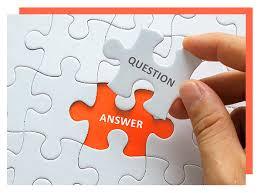
When choosing the right programming language, it’s essential to consider your goals and career. You want to make sure that you choose a programming language that is both in demand and easy to learn. Python is an ideal choice for beginners because it reads like English and has a simplified syntax. It’s also versatile and can be used for anything from web development to software development.
Python
Python is a popular general-purpose programming language that’s easy to learn for beginners and widely used in web development, machine learning, art, automation, and more. It also has a vast community of resources that are available to new programmers.
Java is another widely used programming language, especially for mobile app development. It’s used at companies of all sizes (including HubSpot!) and is one of the easiest to learn if you want to develop for a variety of platforms.Better is to click here or visit our official website to know about Programming question answer.
C is an older programming language but still a good choice for beginners because it’s more “machine-level” and gives you the lowest-level control over computer hardware. It’s also the most common base for other languages, like C# and Ruby.
Java
Despite being not as beginner-friendly as Python, Java is a good programming language to start with. It's a general-purpose programming language with a versatile library and free online tutorials.
It's also a cross-platform language, which makes it suitable for mobile and desktop applications. It's the language of choice for Android development and used in a number of enterprise-level software applications.
C is one of the oldest languages and forms the basis for modern languages like Python, Java, and JavaScript. However, it has a low level of abstraction and requires that code is compiled (translated into machine-readable code) before it can be run. This can make it difficult for beginners to understand. Moreover, its syntax can be confusing. But, it's an excellent foundation for more advanced language learning.
Many people are interested in learning programming, but choosing the best language can be intimidating. Luckily, there are plenty of resources to help you get started. You can learn the basics of multiple languages with a coding boot camp, such as the Georgia Tech Coding Boot Camp, which offers a variety of courses including HTML, JavaScript, and jQuery.
Other popular languages include C, which is a general-purpose, compiled language that’s widely used in back-end software applications like web servers. Python is a versatile programming language that’s easy to learn for beginners and can be used in any application. Ruby is a dynamic, object-oriented language that’s commonly implemented using the Rails framework. Its concise syntax and convention-over-configuration approach makes it easier to build and deploy apps.
Perl
Perl is a high-level dynamic general-purpose scripting language. It is popular among system administrators for its text-processing capabilities, specifically its own in-built version of regular expressions. It is also used for web development and GUI programming.
Beginners can start learning the basics of the programming language by following the free online courses offered on Udemy. These courses begin with basic theory and then move on to specific aspects of the language. They include topics such as lists, arrays, and subroutines. They also cover how to handle errors in coding. Perl has a large community of developers, with over 230 local groups, mailing lists and support/discussion websites. It is also open source and supports more than 25,000 extension modules on CPAN. This flexibility makes it an ideal programming language for beginners.
HTML
Computer programming allows us to create the software and applications that make our lives easier, more entertaining, and more efficient. But deciding which language to learn can be a difficult choice for beginners, particularly when there are so many options available.
youtube
Programming languages may seem different on the surface, but they all have similar structures and features. This means that whichever language you choose to learn, you’ll be learning important coding concepts that will be applicable to any other languages you might decide to explore later on.
Before deciding which programming language to learn, it’s important to consider your goals and current skill level. Once you’ve identified your goals, it’s easy to narrow down your options and find the best programming language for beginners.
2 notes
·
View notes
Text
How Can I Learn Punch Needle Art at Home?
If you’re looking for a relaxing, creative outlet that doesn’t require a fancy setup or prior experience, punch needle art might be just what you need. This embroidery technique uses a special hollow needle to "punch" loops of thread or yarn through fabric, creating beautifully textured designs.
The best part? You can easily learn this calming craft from the comfort of your home—no art degree required. Whether you want to make home décor, personalized gifts, or products to sell online, punch needle embroidery is a rewarding skill anyone can pick up
What Is Punch Needle Embroidery?
Punch needle sewing is similar to painting with yarn or thread. A punch needle is pushed through fabric with yarn or thread to create raised, puffy designs. It is similar to rug hooking, but more open to design and detail.
Even with centuries of its plus points, this trade has gained popularity recently as it is calming and friendly. It can be thought of as both an art piece and a mindfulness activity
What You’ll Need to Get Started
Here’s a quick list of essentials to set up your home punch needle kit:
Punch Needle Tool: Start with an adjustable punch needle. It lets you control loop height depending on your design.
Fabric: For beginners, monk's cloth is the best option. Depending on the type of thread, weaver's cloth or linen also works well.
Embroidery Hoop or Frame: This holds the fabric tight and makes your work easier and more precise.
Yarn or Thread: Medium-weight, soft yarn is easiest to manage for your first few projects.
Pattern Transfer Tools: Water-soluble pens or tracing paper help outline your designs onto the fabric before punching.
How to Learn Punch Needles at Home (Step-by-Step)?
1. Start with Video Tutorials
Search for beginner-friendly punch needle tutorials on platforms like YouTube. Seeing the motion in action will help you grasp the rhythm and technique much faster.
2. Try Simple Projects First
Begin with mini hoops, coasters, or small wall hangings. These quick wins build your confidence before moving on to more complex pieces.
3. Draw or Transfer a Design
Use a pencil or tracing tool to mark out your design on the fabric. Keep it simple at first—clean shapes and minimal detail work best for learning.
4. Begin Punching
From the back of the fabric, push the needle through and lift it out while maintaining even spacing and pressure. Let the needle do the work—don’t force it.
5. Seal & Display
Once you’re happy with your design, secure the back with fabric glue or fusible interfacing. Then frame it, stitch it onto a cushion, or gift it to someone special.
Punch Needle Design Ideas:
Here are a few creative punch needle projects to inspire you:
Floral motifs for cushions or bags
Abstract or geometric wall art
Cute animal portraits in embroidery hoops
Boho-style hangings
Color-blocked patterns for modern décor
These are not only fun to create—they’re popular in the handmade market scene too.
Final Thoughts
Punch needle art is more than just a hobby—it’s a calming, creative practice that offers real joy. With just a handful of tools and a little time, you can turn simple fabric into beautiful, textured art. Whether you're crafting for fun, personal gifting, or even a side hustle, this age-old craft fits perfectly into today’s home lifestyle.So why not give it a try? Punch your way into the world of modern embroidery and let your creativity loop and bloom.
Frequently Asked Questions
If I have never done embroidery before, is it possible for me to learn punch needle art? Yes! Punch needle is one of the most accessible needlework crafts for beginners. Many people pick it up in just a few sessions.
What’s the best fabric for beginners? Monk’s clothes are the top choice. It’s durable and its weave holds loops securely.
How long does it take to finish a project? Smaller projects (like coasters or mini hoops) take 2–3 hours. Larger, more detailed work might take a few days.
0 notes
Text
Driving Art Forward: The Visionary World of Mark Steven Smith and Marks Smith Art Driving
Art has always been about pushing boundaries, reinterpreting the world, and expressing inner truths. For artist Mark Steven Smith, also known by his creative alias Marks Art, art is not confined to canvases and studios. Through his innovative approach known as Marks Smith Art Driving, he invites us to experience art in motion—literally and emotionally.

This blog delves into Mark’s journey, the essence of Marks Art, and how Marks Smith Art Driving is reshaping how we engage with creativity in today’s fast-moving world.
Who Is Mark Steven Smith?
Mark Steven Smith is a contemporary visual artist whose work fuses traditional artistic techniques with experimental mediums and motion-based installations. A native of the American Midwest, Mark’s artistic journey began early, sketching urban scenes from the passenger seat during family road trips. That blend of motion and observation planted the seeds of what would later become his signature concept: Marks Smith Art Driving.
Mark’s work has been featured in various independent galleries and online platforms, praised for its emotive depth and fresh perspective on how movement shapes perception.
The Birth of Marks Art
Under the brand Marks Art, Mark Steven Smith developed a recognizable style that blends raw emotion, urban energy, and kinetic inspiration. His pieces often explore themes like:
Isolation and connection in modern life
The chaos of urban sprawl
The relationship between speed, time, and awareness
While many artists explore these ideas from a stationary vantage point, Mark chose a dynamic one. This led to the birth of his unique approach: Art Driving.
What Is Marks Smith Art Driving?
Marks Smith Art Driving is not just a concept—it’s an immersive practice.
Mark creates artwork while in motion. That’s right—he paints or sketches from the passenger seat of a moving car, often using a mobile setup that includes a stabilizing platform, sketchpad, and various mediums like charcoal, watercolor, or digital tablets. The movement of the car is not a distraction but an intentional part of the creative process.
This technique brings spontaneity and unpredictability to each piece. The motion, light changes, and fleeting glimpses of landscapes all influence the outcome.
Key Characteristics of Marks Smith Art Driving:
Artwork created while in transit (car, train, or bike)
Raw, abstract forms influenced by speed and surroundings
Themes of motion, escape, and sensory overload
Often includes short poetic captions written during the drive
For Mark, this isn’t just a gimmick—it’s a commentary on how modern life is consumed at high speed and how art can help us slow down and reflect, even in motion.
Behind the Wheel of Inspiration
In interviews, Mark Steven Smith often shares how road trips, traffic patterns, city lights, and even GPS glitches inspire his work. He treats the vehicle as both a literal and metaphorical studio—one that’s always changing, always unpredictable.
Here are some insights into his process:
Time of day matters: Morning drives offer soft palettes; night rides bring high-contrast drama.
Location dictates emotion: A bustling city might inspire chaotic lines, while a scenic highway creates meditative flow.
Music influences mood: Mark often pairs his drives with curated playlists that set the tone for each piece.
The Community Around Marks Art
Through social media and local art shows, Marks Art has grown a community of fans who resonate with the project’s philosophy. Many followers share their own #ArtDriving moments—sketching, journaling, or photographing during commutes.
Mark encourages this form of artistic engagement by sharing tutorials, behind-the-scenes content, and live “drive-and-draw” streams, where viewers can watch his art take shape in real time.
Marks Art Projects and Exhibits
Marks Smith Art Driving has been featured in:
Movement & Medium” Art Collective – A digital art show focused on dynamic creation.
Urban Lines: Art in Motion – A pop-up exhibit in Chicago showcasing pieces created during Mark’s Midwest highway travels.
Art on the Move – A collaborative series involving artists painting in public transport spaces.
Mark also sells limited-edition prints through the Marks Art online store, with each piece labeled with the exact route, time, and date it was created.

Why Marks Smith Art Driving Matters
In a world saturated with carefully curated visuals, Marks Smith Art Driving stands out by celebrating the imperfect, the spontaneous, and the deeply human. It reminds us that art doesn’t require a static studio or hours of solitude. Sometimes, all it takes is a moving car, an open mind, and a willingness to create in real time.
Mark Steven Smith’s work bridges the gap between physical movement and emotional stillness. It shows how creativity can thrive in even the most unexpected spaces—and how art can truly drive us forward.
Conclusion
Whether you're a fellow artist, an admirer of contemporary work, or just someone looking for a new way to see the world, Mark Steven Smith and Marks Smith Art Driving offer an inspiring look at what it means to create with intention—even at 60 miles per hour.
0 notes
Text
Top Online Mehndi Courses by Arun Mehndi Classes
Mehndi, also known as henna art, is an intricate and beautiful tradition that has been cherished for centuries. With its growing popularity worldwide, learning the art of Mehndi has become a sought-after skill. Arun Mehndi Classes, a leading platform for Mehndi artistry, offers top online Mehndi courses to help aspiring artists master this craft from the comfort of their homes.

How to learn mehndi design at home?
Whether you are a beginner or a seasoned artist looking to refine your skills, Arun Mehndi Classes provides comprehensive training tailored to all skill levels. Here's an overview of what makes these courses stand out and why they are the best choice for anyone passionate about Mehndi art.
Why Choose Online Mehndi Courses?
Online Mehndi courses have become increasingly popular due to their convenience, flexibility, and accessibility. Here’s why you should consider enrolling:
Learn from Anywhere: With online classes, you can learn Mehndi art regardless of your location, eliminating the need for travel.
Flexible Timings: Courses are designed to fit into your schedule, allowing you to balance learning with work or other commitments.
Expert Guidance: Learn from experienced Mehndi artists like Arun Mehndi Classes, who bring years of expertise and passion to their teaching.
Lifetime Access: Many courses offer lifetime access to materials, allowing you to revisit lessons whenever needed.
Top Online Courses Offered by Arun Mehndi Classes
Beginner’s Mehndi Course:
Overview: Perfect for beginners, this course covers the basics of Mehndi art, including essential tools, basic patterns, and fundamental techniques. Moreover, if you are looking for the best answer to your query of “How do I start learning henna?” you must take the beginner course.
What You’ll Learn:
Holding the cone correctly.
Drawing simple designs like flowers and leaves.
Practicing neat and precise strokes.
Intermediate Mehndi Course:
Overview: For those with basic knowledge of Mehndi, this course delves into more complex designs and patterns.
What You’ll Learn:
Creating intricate bridal motifs.
Developing symmetrical patterns.
Combining traditional and contemporary styles.
Advanced Bridal Mehndi Course:
Overview: This course by A is tailored for aspiring professional Mehndi artists who want to specialize in bridal designs.
What You’ll Learn:
Designing elaborate bridal motifs.
Understanding client preferences.
Adding shading and detailing techniques for enhanced aesthetics.
Creative Mehndi Art Course:
Overview: Now, the question is How to improve mehndi skills? For this, you must look for creative mehndi art courses available online. Focuses on experimental designs, fusion styles, and innovative Mehndi patterns.
What You’ll Learn:
Modern designs and abstract art.
Incorporating glitter and colored Mehndi.
Using Mehndi in body art and tattoos.
Unique Features of Arun Mehndi Classes
Live and Recorded Sessions:
Attend live classes for interactive learning or access recorded sessions for flexible self-paced study.
Step-by-Step Guidance:
Each lesson is meticulously structured to ensure you learn at a comfortable pace.
Practice Assignments:
Regular assignments and feedback help hone your skills.
Certification:
Upon completion, receive a certificate to showcase your expertise, boosting your career prospects.
Access to Resources:
Downloadable practice sheets, design templates, and video tutorials for continuous learning.
Why Arun Mehndi Classes?
Experienced Instructor: Learn from Arun, a renowned Mehndi artist with years of professional experience.
Comprehensive Curriculum: Courses cover everything from basic strokes to advanced techniques.
Global Community: Join a network of Mehndi enthusiasts and professionals to exchange ideas and inspiration.
Affordable Pricing: Quality education at competitive rates ensures great value for money.
Start Your Mehndi Journey Today!
Arun Mehndi Classes offers the perfect opportunity to turn your passion for Mehndi art into a valuable skill or even a professional career. With expert training, a supportive community, and top-notch resources, you’ll be equipped to create stunning Mehndi designs that captivate and inspire.
Enroll in one of the top online Mehndi courses today and embark on a creative journey like no other. Visit Arun Mehndi Classes to learn more and start your artistic adventure! To get more details, check https://arunmehndiclasses.com/
0 notes
Text
The Craftsmanship and Style of Mosaic Mirrors
Mosaic mirrors are beautiful works of art that have the power to completely change any room in addition to being useful objects. These ornamental pieces give a distinctive touch to interior spaces by fusing the exquisite patterns of mosaics with the reflecting beauty of mirrors, which makes them a popular option for both designers and homeowners.
A mosaic mirror: what is it?
A mosaic mirror is one that has a frame made of tiny bits of glass, ceramic, or other material that has been artistically set around the mirror. Originating in ancient cultures, the mosaic method has been around for thousands of years and has become a prominent style of contemporary art. The dazzling pieces exquisitely capture light, resulting in a kaleidoscope of hues and reflections that can elevate a space's visual appeal.
The Background to Mosaic Art
The Background to Mosaic Art
With origins in prehistoric societies like the Greeks and Romans, mosaic art has a long and illustrious history. These societies created elaborate patterns for floors, walls, and even ceilings using tiny bits of glass and stone. Mosaic-making became popular throughout Europe and the Middle East over antiquity, giving rise to a variety of styles and methods. This age-old craft is still practiced today with mosaic mirrors, which let contemporary artists express their originality and artistry.
Versatility in Design
The adaptability of mosaic mirrors is one of their most attractive features. You can easily select one that matches any décor because they are available in a variety of sizes, shapes, and color schemes. There is a mosaic mirror for every taste, ranging from striking, vibrant designs that act as headline pieces to more somber, minimalist ones that fit in perfectly with a room.
Traditional: Traditional mosaic mirrors can arouse feelings of nostalgia and the past because they frequently have elaborate designs and subdued colors.
Contemporary: Geometric patterns and vivid colors are prominent features in many modern designs, which make them eye-catching focal points in any space.
Rustic: Natural materials or aged mosaic mirrors can provide warmth and charm to a room with a rustic vibe.
How to Make a Mosaic Mirror
For people who prefer doing their own crafts, making a mosaic mirror is a fun and satisfying endeavor. Here's a quick tutorial on creating your own:
Supplies Required:
A simple mirror
mosaic tiles made of stone, ceramic, or glass
(Glue or tile adhesive) adhesive
Grout—optional, based on the style—
Tools: safety glasses, a sponge, and tweezers
2. Actions:
Create a Layout: Arrange the tiles on the mirror in a planned manner. You can draw pictures, patterns, or abstract artwork.
Fix the Tiles: The mosaic tiles should be glued to the mirror frame. Firmly press them down.
Grouting (Optional): Use grout to fill in the voids left by the tiles. After letting it harden, use a moist sponge to remove any remaining material.
Final Touches: Hang your mosaic mirror and take in your creation after everything has dried!
Upkeep and Scenario
Cleaning your mosaic mirror on a regular basis is crucial to maintaining its best appearance. To clean the mirror, use a soft cloth; do not use abrasive cleansers as they might cause scratches on the glass or harm the tiles. If grout is used, sealing it on a regular basis could be required to stop moisture damage.
In summary
Mosaic mirrors are compelling works of art that showcase the beauty of handiwork, not just mirrored surfaces. A mosaic mirror can improve the décor of any room in your house, whether you decide to make your own or buy one. It adds a sense of style and individuality. You will find that there are countless opportunities for creativity and self-expression when you go deeper into the world of mosaic art.
1 note
·
View note
Text
Creative Wallpaper Designs That Will Inspire Your Next Bedroom Makeover
When considering a bedroom makeover, the importance of a new design wallpaper must be considered. A well-chosen wallpaper can affect mood, reflect personal style, and set the tone for the space. Many alternatives are available, ranging from delicate watercolour designs to aggressive geometric patterns. This tutorial looks at many imaginative wallpaper patterns to get you started on your next bedroom makeover.
Abstract Wall Art: Unleash Your Space's Creativity
Abstract art wallpaper is ideal for people who value art in their living spaces since it adds a pop of modernism and originality. Unpredictable patterns and various hues are common elements of abstract designs, which can complement any bedroom motif. Abstract wallpaper, whether muted swirls or bold splashes, adds sophistication to any bedroom.

Geometric Wallcoverings: Introducing Style and Structure
Well-defined lines and recurring patterns of squares, triangles, and hexagons characterize geometric wallpaper. For people who prefer a tidy and orderly space, this kind of wallpaper for bedrooms can help establish a sense of order and harmony. In addition to lending an air of refinement, geometric patterns can blend in with traditional and modern interior design.
Graffiti Wall Art: A Modern Touch for Your Sleep Space
Graffiti wallpaper infuses your room with street art's vivid, unadulterated spirit. It's ideal for creating a big impression and looks great in a teenager's bedroom or anyone who enjoys modern, edgy design. Graffiti wallpaper is an excellent way to add artistic expression to a plain wall because of its vibrant colours and eye-catching graphics.
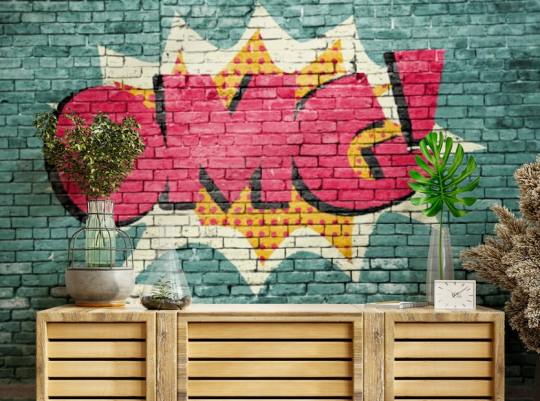
Watercolour Wall Art: Calm and Comforting Styles
It's like having a hand-painted mural in your bedroom with watercolour wallpaper. This design, well-known for its gentle, flowing colour transitions, can give your bedroom a serene and creative atmosphere. It's especially appropriate for people who want a softer, more muted aesthetic for their bedroom design.
Art Wallpaper: Give Your Bedroom a Gallery Feel
Art fans can showcase their favourite pieces of artwork on a bedroom wall by selecting art wallpaper. This might vary, based on personal preference, from modern artwork to prints from the ancient era. By fostering a sense of intimacy, art wallpaper transforms your bedroom into a showcase for your appreciation of many cultures.

Wallpaper with a chino style: exotic elegance
East Asian art inspires the elaborate patterns and artwork found in chinoiserie wallpaper. This kind of wallpaper is distinguished by its intricate depictions of natural scenes, including blossoming flowers, birds, and picturesque landscapes. Chinoiserie offers both classic style and visual appeal, bringing an exotic and opulent air to your bedroom.
Wallpaper with ombre colours: a gentle colour shift
The gradient effect of ombre wallpaper sets it apart as the colours progressively meld together. This might produce a tranquil atmosphere that is perfect for a bedroom. When the colours flow smoothly from one to the next, a space can seem larger and airier.
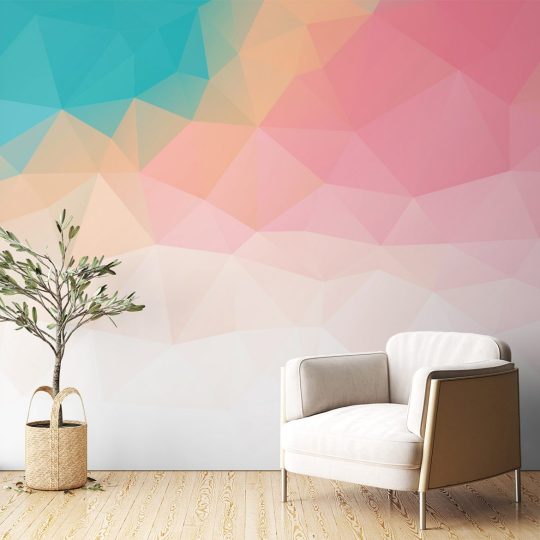
Wall Murals: Customize Your Environment
Bedroom wall murals are ideal for anyone who wants to display large-scale artwork and express their unique style. A wall mural is a feature that makes a space stand out, either by depicting a cityscape, a beautiful landscape, or an abstract design that changes the room's entire appearance and atmosphere.
Conclusion
Your bedroom's look and ambience can be greatly influenced by your chosen wallpaper design. The ideal wallpaper may enrich and compliment your bedroom area, regardless of your preference for the tranquillity of watercolour designs, the boldness of graffiti, or the elegance of geometric patterns. Think about how these wallpaper choices complement your own style and make your bedroom a more inspiring and pleasurable place to live as you plan your remodel.
0 notes
Text
Created with AIPRM Prompt "Human Written |100% Unique |SEO Optimized Article"
Outline:
Introduction to Waka Sopro
The Emergence of Waka Sopro
Origins and Evolution
Rise in Popularity
Key Factors Contributing to Waka Sopro's Success
Therapeutic Benefits
Accessibility and Affordability
Social Media Influence
Waka Sopro's Impact Across Industries
Art and Creativity
Mental Health and Well-being
Fashion and Design
Celebrity Endorsements and Influencer Partnerships
Conclusion
From Zero to Hero: How Waka Sopro Became the Hottest Trend of the Year
Give my new GPT a try: https://bit.ly/Jumma_GPTs
Introduction to Waka Sopro
In a world where trends come and go, one artistic movement has captured the hearts and minds of people around the globe: Waka Sopro. From its humble beginnings to its meteoric rise to fame, Waka Sopro has become the hottest trend of the year, captivating audiences with its beauty, accessibility, and transformative power.
The Emergence of Waka Sopro
Waka Sopro's journey from obscurity to ubiquity is a testament to its resilience and universal appeal. Born out of a desire for creative expression and emotional release, Waka Sopro has its roots in ancient Japanese artistic traditions, which have evolved over time to encompass a wide range of styles and techniques.
Origins and Evolution
Initially practiced by a niche community of artists and enthusiasts, Waka Sopro gradually gained traction as more people discovered its therapeutic benefits and creative potential. What began as a grassroots movement soon blossomed into a global phenomenon, with practitioners from all walks of life embracing Waka Sopro as a form of self-expression and personal growth.
Rise in Popularity
Fuelled by social media and word-of-mouth, Waka Sopro quickly spread across continents, captivating audiences with its mesmerizing visuals and transformative effects. From online tutorials and workshops to dedicated hashtags and viral challenges, Waka Sopro's rise in popularity has been nothing short of remarkable.
Key Factors Contributing to Waka Sopro's Success
Several key factors have contributed to Waka Sopro's meteoric rise to fame:
Therapeutic Benefits
At its core, Waka Sopro offers a therapeutic escape from the stresses and pressures of modern life. Many practitioners turn to Waka Sopro as a means of relaxation, stress relief, and emotional catharsis, finding solace in the rhythmic motion of brush strokes and the vibrant hues of paint.
Accessibility and Affordability
Unlike traditional art forms that require specialized skills and expensive materials, Waka Sopro is accessible to anyone with a desire to create. With just a few basic supplies and a willingness to experiment, anyone can try their hand at Waka Sopro and experience the joy of artistic expression.
Social Media Influence
Social media platforms have played a pivotal role in popularizing Waka Sopro and connecting practitioners from around the world. From Instagram and TikTok to YouTube and Pinterest, Waka Sopro has become a staple of online culture, with millions of posts, tutorials, and hashtags dedicated to this captivating art form.
Waka Sopro's Impact Across Industries
Waka Sopro's influence extends beyond the realm of art, reaching into diverse industries and sectors:
Art and Creativity
In the world of art and design, Waka Sopro has inspired a new wave of creativity and innovation, with artists incorporating its principles into their own work. From abstract paintings and mixed media collages to fashion designs and home decor, Waka Sopro continues to push the boundaries of artistic expression.
Mental Health and Well-being
Waka Sopro's therapeutic benefits have also caught the attention of mental health professionals, who recognize its potential to promote emotional well-being and self-care. Many therapists and counselors incorporate Waka Sopro into their treatment plans, using art as a tool for healing and personal growth.
Fashion and Design
In the world of fashion and design, Waka Sopro has emerged as a source of inspiration for designers and creatives. From runway collections to interior decor, Waka Sopro's vibrant colors and bold patterns have left an indelible mark on the world of design, infusing everyday objects with a sense of joy and vitality.
Celebrity Endorsements and Influencer Partnerships
The allure of Waka Sopro has not gone unnoticed by celebrities and influencers, who have eagerly embraced this artistic trend and shared their creations with millions of followers. From Hollywood A-listers to social media influencers, celebrities have played a key role in popularizing Waka Sopro and bringing it to the forefront of popular culture.
Conclusion
In conclusion, Waka Sopro's journey from zero to hero is a testament to its universal appeal and transformative power. From its humble beginnings to its current status as the hottest trend of the year, Waka Sopro has captured the hearts and minds of people around the world, inspiring creativity, fostering community, and bringing joy to all who encounter it.
0 notes
Text
Black and White Wall Art
Shades of Sophistication: Embracing Black and White Wall Art
Hey Tumblr friends!
Today, let's dive into the beautifully stark world of Black and White Wall Art. It's more than just a lack of color—it's a bold statement, a return to basics, and a dramatic interplay of contrast and texture that can transform any space.
Why We Love Black and White Art:
Simplicity and Sophistication: Black and white art strips down the visual experience to its core, focusing on form, light, and shadow. It's straightforward yet profound, creating a sophisticated vibe that's hard to overlook.
Versatile Decor: Whether your room is a colorful array of personal expression or a model of minimalist chic, black and white pieces fit right in. They bridge styles, eras, and color schemes, making them the ultimate versatile decor.
Emotional Depth: Without the distraction of color, black and white art makes us feel. From the serene to the dramatic, these pieces convey emotion in every shade of gray.
Spotlight on Iconic Pieces & Artists:
Let's not forget about the trailblazers who've made black and white art what it is today. From Ansel Adams' majestic landscapes to the compelling abstracts of modern artists, these works continue to inspire and captivate.
DIY or Buy? Finding Your Perfect Piece:
Whether you're a creator looking to make your own black and white masterpiece or you're in search of the perfect piece to adorn your walls, there's something out there for you. I'll drop some links to my favorite collections and maybe even share a tutorial or two for the DIYers!
Styling Tips for Every Space:
Here's how you can make black and white art the star of your space. Consider the mood you want to set and the existing elements in your room. And remember, art loves company—think about creating a gallery wall for an impactful visual statement.
Your Thoughts:
What are your experiences with black and white wall art? Got a favorite piece or artist? Or maybe you're looking for advice on how to incorporate these pieces into your space. Drop your thoughts, pics, or questions below!
Black and white art isn't just about what's absent; it's about what's there. The shapes, the shadows, the light, and the textures all tell a story. So, whether you're a longtime lover of monochromatic magic or new to the scene, embrace the boldness and beauty of black and white wall art.
Until next time, keep it classy and creative!
#wall art#art print#interior decor#wall decor#home decor#prints#design#pattern#unique#interior design#decorative#decor#abstract#decorative arts#geometric#home decorarion#interior architecture#printmaking#woodworking#canvas prints#photography#artwork#art prints#artist#fractal art#surfaces#poster#murals#retro#painting
1 note
·
View note
Text
january: an art retrospective
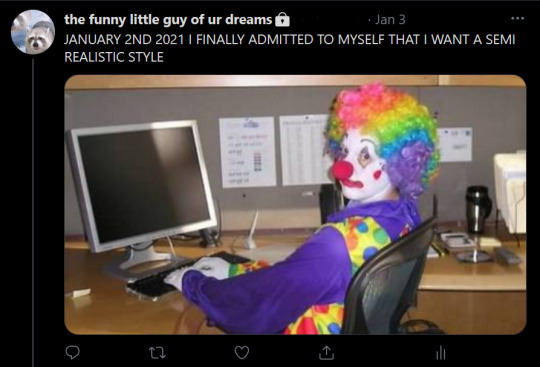
i did some stuff last month (but it’s a lot of stuff and there’s a photodump + some Serious Fucking Reflection, so it’s all below the cut)
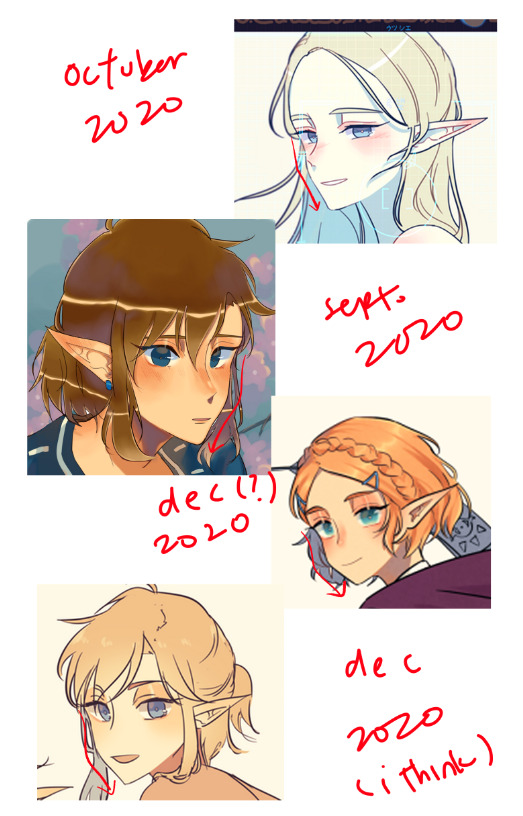
so ok, let’s start with this. here are some heads. each head has a red arrow. that red arrow is what i call the red line of the devil. it’s the slope of the face from the side of the eye to the cheekbone and then down towards the chin. up until like 2 weeks ago, i couldn’t draw it. i couldn’t fucking draw it. i would edit over that part of the face over and over again until i was frustrated and tired and i had a raging homosexual headache and it still never looked right. notice that each head is different. notice that each head looks wrong.
at the start of 2021 i finally admitted to myself, as per the image above, that i was deeply, deeply unhappy with my art. what was the problem? i dunno. but i decided i was going to fix it and i was going to do so via another one scribble a day event wherein for every day of january i would find a photo of a human head, and i would draw it.

january 1st, 2021. i was embarrassed to tweet this even on my private account where like 5 friends and a rock would see it. in retrospect, you can also see all of my bad habits emerging like dicks from a hole in the ground. it’s disproportionate. the brows look flat. the eyes are slanting upwards. the entire drawing looks flat, like this isn’t a 3d person but a caricature of one.
january 2nd, 3rd, 4th:

on the 2nd i decided to start a separate thread for doodles and applied learning. here’s the first set of tests
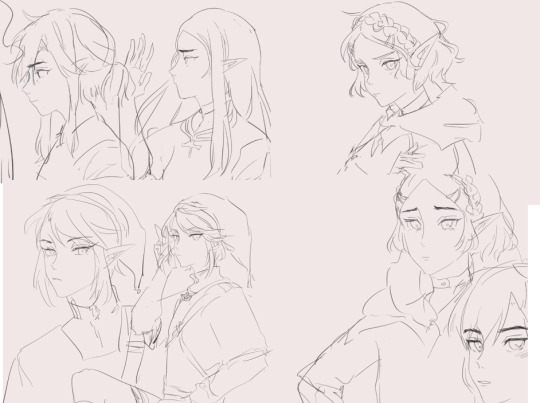
the rest of the week is kind of uneventful so we’re going to skip those. fast forward to january 11th
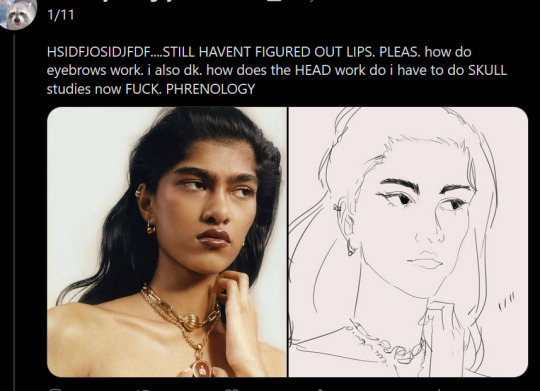
this one is especially bad. i am acutely aware, suddenly, that i am not changing anything at all. i’m stressed and miserable about it because i’m still trying to see people as people and trying to draw people that look attractive and proportionate and hot. my friend, leny, reminds me that i need to think about faces in terms of planes. i have a moment. my other friend masha sends me some links to anatomy tutorials. i have another moment.
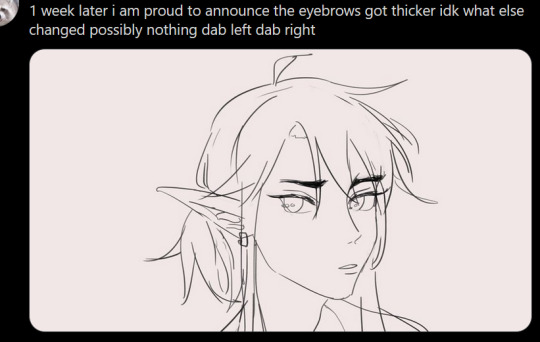
january 11th. applied sketch
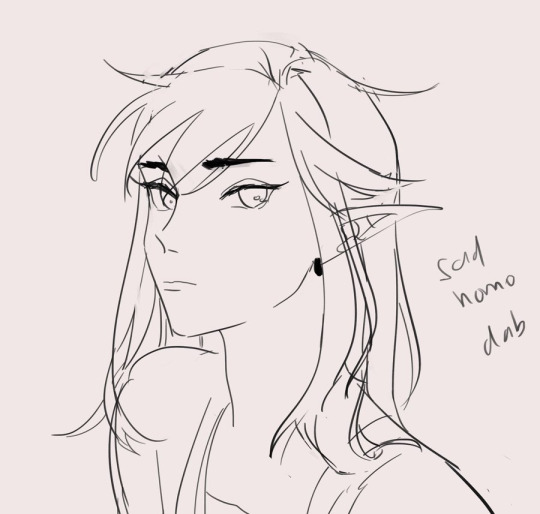
january 13th is when i start the troubleshooting process. the link above drives me mad because i’m pretty happy with the face but then i realize that there’s something very fucking wrong with the shape of the head LOL and then i realize that i’ve never had any idea what the proportion of the face to the rest of the skull is so i grit my teeth and i open a new canvas and i
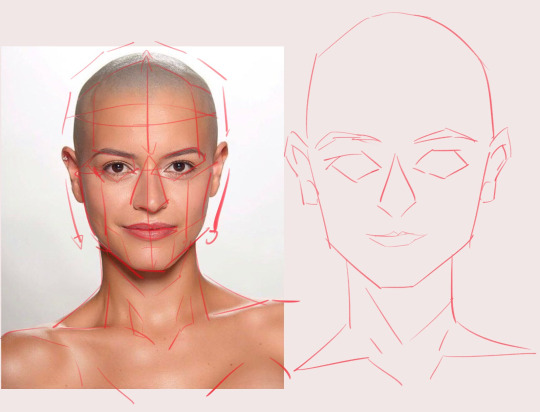

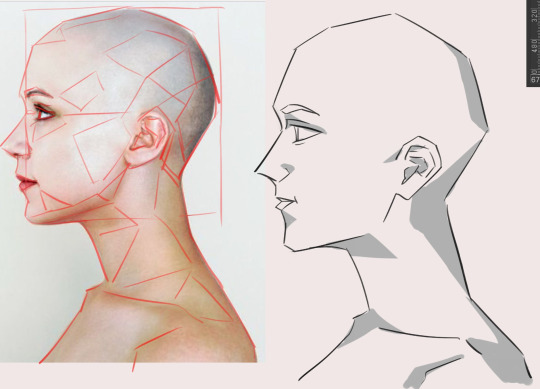
bald studies. it seemed like the right thing to do. can’t draw heads? ok draw some heads. look at some photographs. i traced each photo but tried to stick to straight lines so that i could replicate the shapes more easily. i broke each face down into shapes. i thought about airplanes
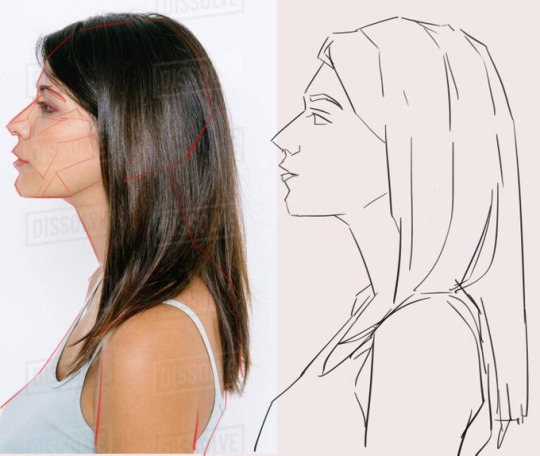
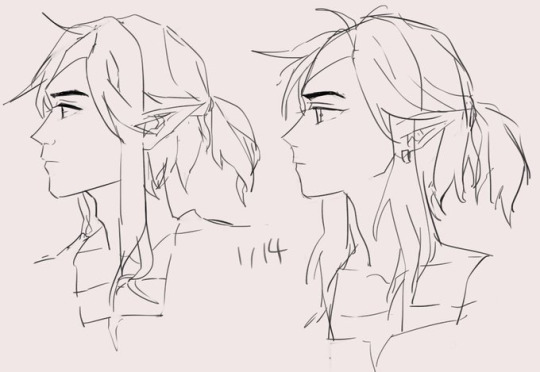
i got really excited. i started doing studies, then applied studies, then stylized studies.
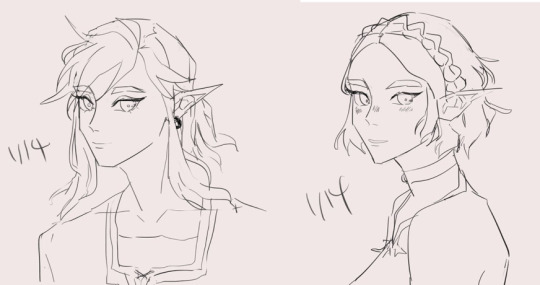
sketches. i’m not sure what’s going on (as always) and it’s very rough, but they look different from the sketches i did on january 2nd. that’s a start
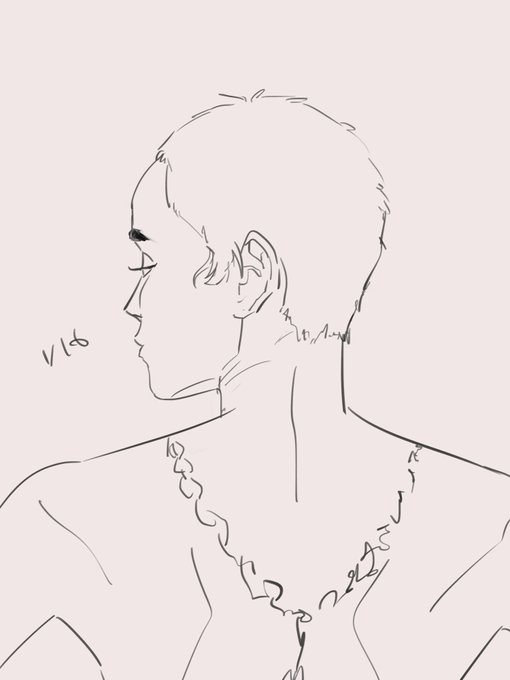
january 16th’s daily study. looks more like a person now. juuuuuust a bit
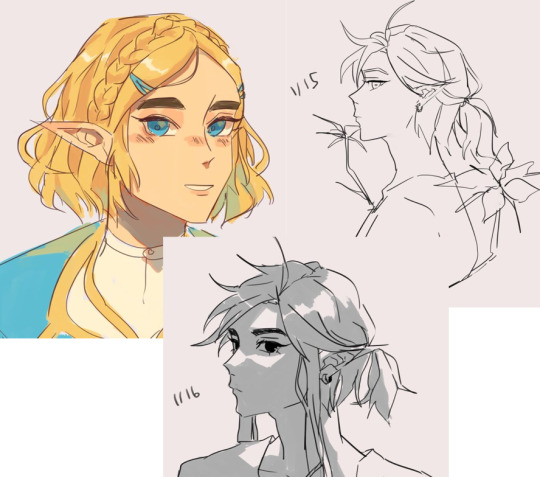
more applied studies
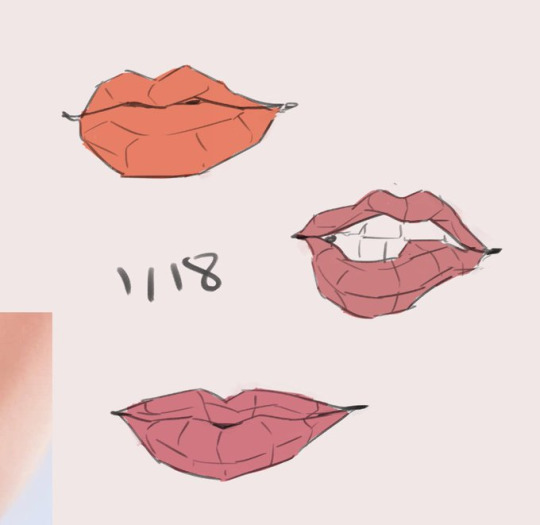
on the 18th i take a break and go stare at some lips because i don’t understand how the fuck they work. again, i focus on shapes, on volume, on the fact that these things exist in 3d. holy fuck lips exist in 3d. holy fuck we are real
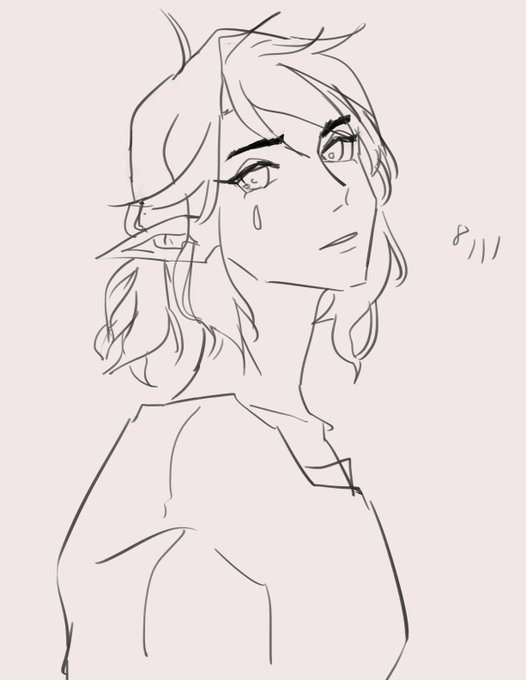
january 19th. i’m working on it.
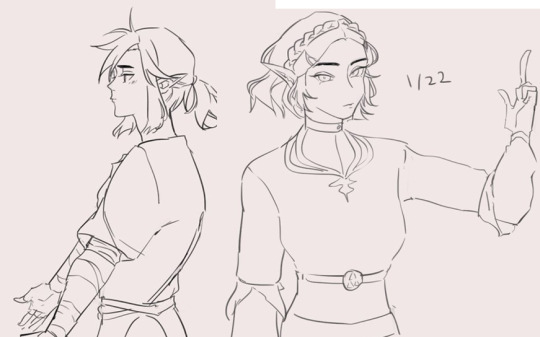

january 22nd. some sketches + a daily study. it has finally occurred to me that heads can tilt up and down and that things look different accordingly. yes i was not aware of this before. yes i have been drawing for over a decade.
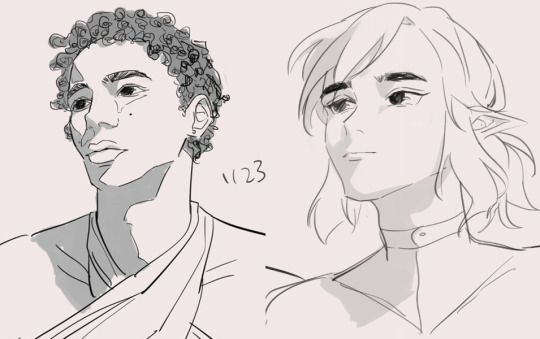
january 23rd. by this point after doing my daily sketch i almost always go back and do an applied study which is basically to say i drew a lot of fucking links. this one looks kind of okay. i’m kind of proud
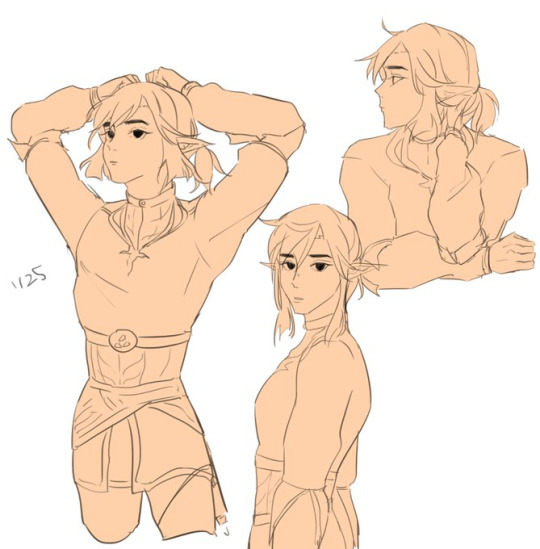
january 25th. links. trying to make sense of everything i’ve learned
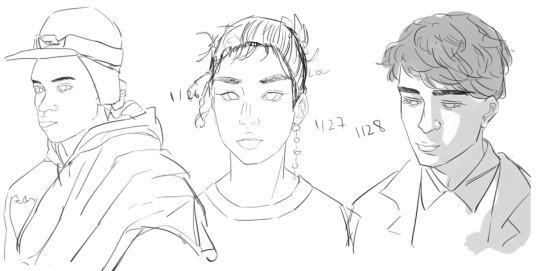
26th, 27th, 28th. daily studies
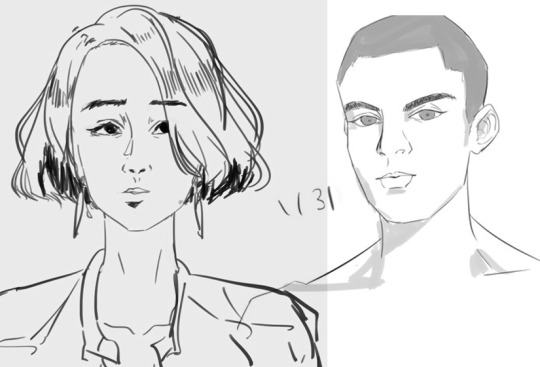
january 1st. january 31st
The End Of The Photo Dump (dab)
ok NOW i get to talk about what i discovered while studying the shit out of human beings
FIRST OF ALL, there is something precious and magical about drawing shit without the explicit knowledge that you’re going to tweet that shit out to 45 people later. it takes the burden of perception off your shoulders and that does something to you, or at least that’s my theory. i told myself i wouldn’t post any of this stuff until the end of the month (if i wanted to post it at all) and kept everything off my public social media accounts and that meant i could draw ugly as hell without worrying about who would point and laugh, which i absolutely fucking did. a lot of these are fucking trainwrecks. most of these are fucking trainwrecks. why do they look like that?? why??? this doesn’t look like the work of someone who’s allegedly been drawing since they were in kindergarten, does it?????
here’s why: because that person took a huge motherfucking swing at everything they’d ever known about art and spent a month building something new in its place. the abstract explanation is that i grew up on shoujo and weird old anime and my understanding of anatomy was unironically kamichama karin and while i love kamichama karin, when kamichama karin is your rule even if you try to break it, you’re going to end up going nowhere. “you have to know the rules to break them”, yeah? well i didn’t know shit. the abstract explanation is i’ve been miserable about my art for a few years now because i saw other people doing things effortlessly which i couldn’t and instead of going back to the basics, i tried to do what they did (not plagiarism, mind you, i mean i literally tried to copy the red line of the devil i mentioned above because i couldn’t even make that happen) and then i fucking failed.
the simple explanation is this. i had to unlearn everything, and relearn it again (like some kind of new renaissance clown, what the fuck is this?)
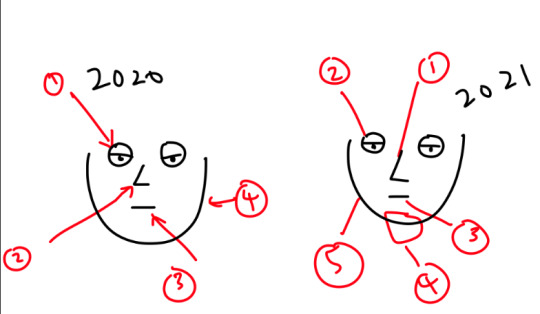
take this for example. all my life i’ve drawn faces in the order: eyes, nose, mouth, face shape, head. this works for some people, im aware, but it was something central to how i had always drawn, so i decentralized it. i said fuck you to the old me and changed the order up. now i start with the nose, then the eyes, mouth, the chin line, and the sides of the face. now i force myself to think about the human head as a series of parts interacting with each other instead of a bunch of disparate features which i want to look pretty.
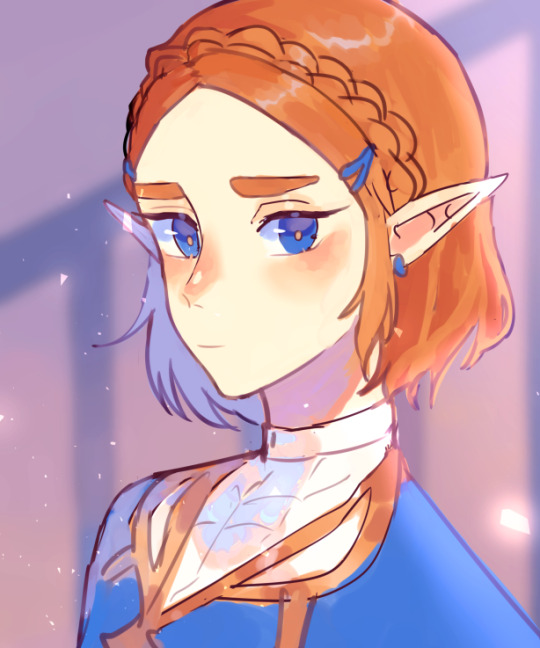
or let’s use this zelda from last year. something about this looked wrong last october, the way something about all of my drawings looked wrong, but i couldn’t pinpoint it for hell the way i couldn’t articulate Any of my feelings about the visual arts. now, looking back, here’s what i see. that nose is sticking out far too much given how she’s not really facing very far away from the camera. that ear at the back shouldn’t be there. her forehead is too big. she doesn’t have a forehead. what the fuck is up with the shape of her head?
so apparently reject modernity embrace tradition has its roots in alt-right terminology and i’m not very horny for the alt-right (you understand), but the spirit survives here. you know sometimes you have to admit that you have no idea what the fuck you’re doing and draw people for 31 days. i’ve spent my whole life drawing stylized people and while again there are artists who have no issue with this, i veered off the track of the Good and the Holy and couldn’t get back on. i had no point of reference because i’d never thought about what an actual human being looks like, so i had no way to fix what i knew in my gut looked wrong but wouldn’t come out better.
this was hard. this was like oikawa tooru swallowing his worthless pride and admitting that ushijima wakatoshi had gotten the best of him for the last time in his high school career, but in haikyuu!! by furudate haruichi oikawa tooru fucks off to argentina and then joins the argentinean national team, and you know what, i think i’ve made it to argentina (not the team just the country). as per the golden rule of dont fucking move until you’re at least two thirds of the way through the month, i only started trying to draw Shit shit on like the 22nd or something, but i was happy with that i created. i am happy with what i’ve done. i’ve posted like 2 things this month that involve people with what i now call ~applied Knowledge~~ and they’re, like, not perfect obviously (perfection is an unattainable ideal), but i’m fucking proud of them. i didn’t spend 5 hours hunched over my laptop adjusting the red line of the devil because it’s not a devil’s line anymore. because i finally sorta get how people work. because i sat down and i said ‘we are not going to fuck with this misery shit anymore’ and then i did that. it’s just a line now.
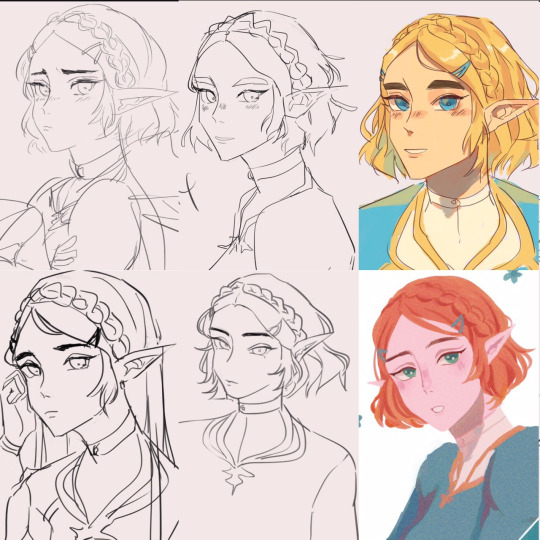
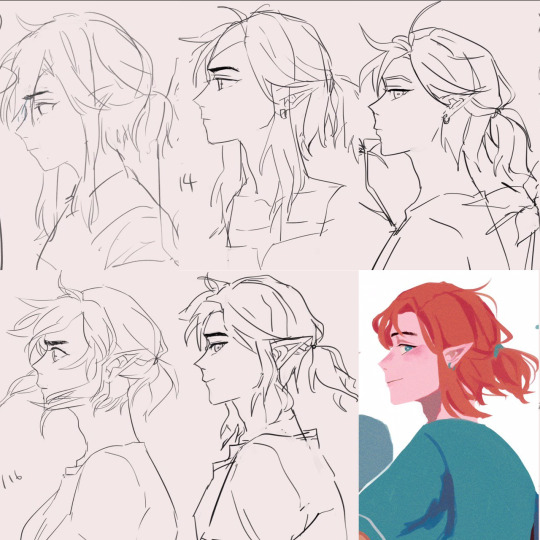
here are 2 collages tracking my painstakingly carved out progress from january 2nd to february 2nd because i’m a slut for collages
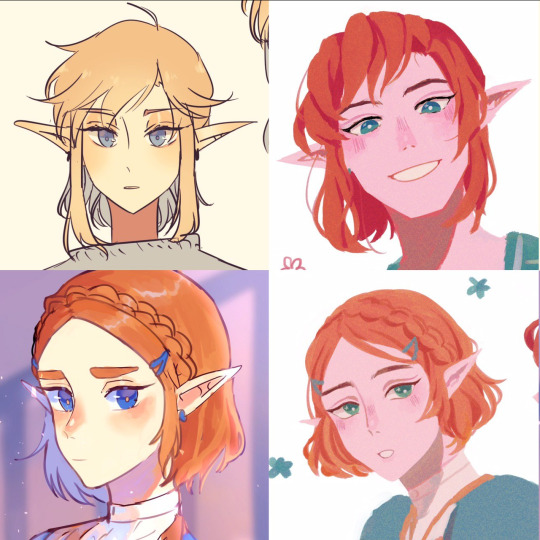
and here’s what i’ve done to my art! the same person drew these but also Not Really! you know! for the first time in a year i don’t immediately hate what i’ve drawn. you know what guys? art is fucking fun. zelda’s forehead doesn’t scare me anymore because i know how foreheads fucking work now, and i don’t know everything, and i’m going to keep troubleshooting stuff as i go (i want to draw a skeleton. like a. i want to draw a goddamn skeleton guys) but i’m honestly and genuinely proud of what i’ve done in the span of a month, and i’m also in disbelief. i started this month-long challenge out as a last ditch effort to make peace with my art because i’ve been tired for a long time and i was ready to kick the bucket on drawing people altogether. i didn’t think anything would happen. nothing’s happened for years. i’ve been miserable for years.

this was the caption for january 1st, 2021. i was super, super fucking embarrassed and it looks like super fucking shit, but you know what, i think i did in fact triumph over the bullshit. surprisingly enough, when you put in consistent effort into something, You Will See Results. didn’t see that coming, did you? i know i didn’t.
this isn’t a success story. it’s a happiness story. i never gave a shit damn about the institute of art or whatever, i was just mad at myself because what i saw in my head didn’t match up with what was on the canvas. and now it’s getting better. now i’m calibrating the compass. now drawing not just backgrounds but also people is exciting to me, and i can stick my links in your face and tell you ‘they hot’. i’m going to keep doing that. i’m going to keep going until i drop off the side of the earth and then spiral towards mars like some kind of fairy, and then i’m going to create something beautiful.
thanks for reading. here’s a pr department link for sticking around until the end
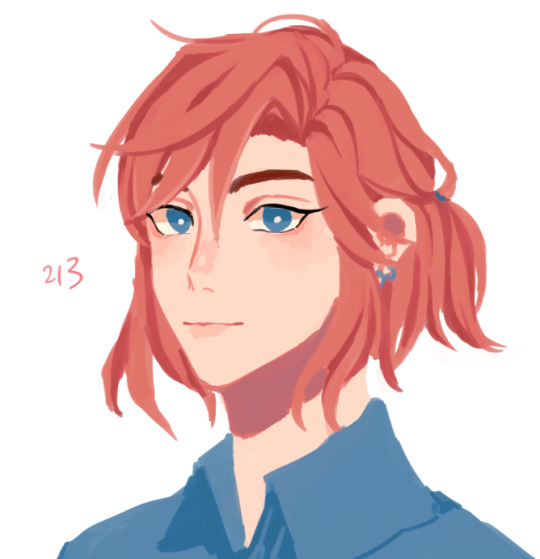
207 notes
·
View notes
Text
organising an art practice?
someone on a discord server asked me this question
I'm almost done with some examinations, which will give me time to work on myself artistically, and I've got about 50+ tutorials to help. I want to schedule my time properly for next year and really study these tutorials I've got. The thing is, it all feels overwhelming, and though I've selected a few to start with, I don't know what kind of scheduling to do. Like should it be like a school timetable? Or is there another kind of time scheduling I'm unaware of.
Could I get your thoughts on how to go about this?
Thanks!
my answer is so long that I decided to cut it here instead:
gosh, tough question, i've never designed a curriculum before!
what has worked for me is generally speaking to just throw myself into projects and when i'm finding something hard, e.g. how do i draw the muscles of the shoulder, i'll have a strong curiosity-driven motivation to look up references and learn about that thing. this means my knowledge tends to me kind of eclectic, but i really struggled with preset plans of study at university so for me the biggest thing is making sure i am motivated. so having a bunch of different projects so when I'm a little burned out on project A, I can put some time on project B is my way of wrangling the old ADHD. i find stephen zapata's framing of an 'art practice', like a set of habits around how you go about drawing, is a good angle on it.
i also think a project-based approach will train the more abstract, harder-to-teach skills, like coming up with ideas and working out the sort of subjects you personally like to draw; that passion is the foundation of whatever you ultimately end up saying with art. tutorials can be very limiting - I think it’s better to treat them as a kind of reference manual than a program of study.
that said, let's see. i think the thing about the overwhelmingness is like, there are so many different dimensions to art, and you get the impression you have to be able to do everything perfectly. you kind of get the impression that the really good artists can do everything, but that's not really true.
once, kim jung gi, who everyone tends to praise as like one of the absolute masters of classical draughtmanship, perspective, etc., tried to draw an anime girl from memory and it ended up looking very 80s-anime, rather than the modern, graphical style he wanted. that's not a failing, no question he could crack it if he wanted to - drawing anime just not relevant for the kind of art he likes to do. so the trick is to identify what's relevant to what you like doing. but it sounds like you've done that.
i’m sorry, this isn’t really very concrete, but I have never been able to keep a rigid schedule and my life is very chaotic. so for me the trick is to create a self-sustaining feedback loop that keeps me wanting to draw, whenever I happen to find the time. i think the danger of being too programmatic is burnout: you need art to be intrinsically fulfilling, not just an endless list of tasks to do. which is why i don’t personally go for the drawabox method, but i know that suits other people a lot better who really like doing exercises to hone the fundamentals.
the canmom way (don’t do this)
for my part, let me try and explain the path i've taken and maybe it will be useful for you (at least in a “don't do this” way :p )
the last year or two of trying to learn drawing seriously (instead of drawing only occasionally), i've tried a bunch of different things. when i started i believed i could make a one minute film, and started sketching some concepts and animatics, (see https://giant-head.tumblr.com/ ) but i soon realised my drawing was just not up to the task: i couldn't draw consistently or cleanly enough and my anatomy wasn't very good.
so then i started one huge project i've been working on for over a year now. it started as an attempt to teach anatomy by drawing a bunch of different angles, yet once again I tried to just, added more and more stuff I thought would be cool: extreme camera moves, character acting, action hair, explosions, fully coloured in an 80s anime style, almost all on 1s for about ten seconds of animation. i learned a lot from that project, it really improved my anatomy for example, but it definitely feels like it's outstayed its welcome by now! but i also think i had to get that out of my system, prove that i could do something without taking shortcuts. and I am proud of the result.
idk. this is just me lol. it's kind of why i feel sympathetic to cat [another user on the discord server], we both have that perfectionist impulse.
so what's a better way? for me it was really useful to find a structure where I could do short projects.
I joined the 'speed battles' server, and participated in a few of those, where you just animate for a couple of hours on a prompt and post it with some other people. the same goes for '-tober' style prompts, and especially the Animaitsuki challenge on the Sakuga Foundry server, and no doubt the monthly challenges here. (Animaitsuki is probably most useful if you want to work in anime since the Tonari guys critique it). also things like figure drawing sessions.
all of that helped me be less perfectionist. and it also means that like, I actually finish stuff: i have two or three hours and then i have to post it no matter what. i just try and fit those in as often as possible, I don't really have a schedule.
i've never really sat down and worked through tutorials, but what I have done is written tutorials, and I actually think that's more useful because it forces you to engage with the material more accurately. with the perspective series i drew a lot of very technical perspective exercises and like, really internalised all the rules of perspective, and also worked out how to organise it in my mind and make the theoretical connections that help it all 'click'. so i think, if you really want to make absolutely sure you learn something, try teaching it, and writing some notes or a tutorial. and i think it's also really helpful to like, just pick someone who's posting on here and offering them some constructive critique, maybe even a redline if they're willing, because that will develop your critical eye at the same time it's helping them.
i also spend a lot of time watching art youtube when i'm not able to draw, e.g. over meals. for this I mostly just follow the algorithm and click on videos about whatever i happen to be thinking about at the time. but i think that can be a double edged sword, there's a lot of conflicting or bad advice, but it can help give you concepts to anchor onto if you take it critically.
it sounds like you already know what videos you want, so I guess the tl;dr of this is don’t overthink it. whatever stands out at a glance, block out two or three hours and have a go at applying it. if you find you’re hampered by some other missing ‘element’, practice that. try not to get too attached to one project, but use the projects as reasons to look up references, resources and tutorials: e.g. if you’re drawing a shoulder, watch the shoulders video. that’s the only way that’s ever worked for me.
5 notes
·
View notes
Text
Reflection
From last week tutorial, I gathered that I was being too scattered and kept on changing directions too many times. This very relevant observation was difficult to realise. I wasn’t happy with the <<progress>> of the work I had made, and lost track of where I was going and what I was doing.
This week I deeply reflected on what truly interested me and what I really wanted.
My work directed towards “form over content” wasn’t made intentionally; I took that direction because of my incapacity to find a “content” that I would feel truly invested or interested in. I felt insecure towards a more personal approach to my work as opposed to something more academic.
“What is the use of creating emotion-based work?”, was a recurrent question that came to my mind.
The constant switch between visual styles was also a struggle of mine as I was paradoxically trying to “please others”, in the sense that I wanted to create something that would be liked by a bigger audience.
I felt confused by the terms “position”, “practice” and “critical position”. Do I really need to define them this soon, is there even a need to define them? Is it wrong to be or feel lost?
Maybe the sense of loss or the loss of self could be a position?
I have always been quite precious with my work and value quality over quantity, and this entire project has been difficult for me so far as the whole point of it is to produce at a high volume (which I haven’t been successful with, at all).
The reason why last tutorial didn’t go well in my opinion (in terms of what I had done), is that I tried to change direction again, out of indecisiveness and my fear of making “meaningless work”. I tried to switch the direction towards something I thought would be more lighthearted but also something that would be more accepted.
I realised this week that I had to find a way to ground myself, and after writing my essay and doing research, I realised that I was clearly more interested in personal and intimate work.
I remember being particularly confused after reading “the death of the author” and it really made me question my own position: am I an author? Is authorship really dead? Is it really impossible to be an author at all?
These questions aside, I was also wondering if it was “wrong” to create around oneself, and if it was really an egotistical and selfish act.
So instead of thinking about how people would perceive me based on the work I produce (something that holds me back a lot), I started thinking about the artists I like and the art they make or made.
I have also been significantly drawn to my Moroccan and French heritage and how I could potentially implement elements of my heritage into my work in subtle ways, and maybe merge them together.
I have been researching around Moroccan female artists specifically.
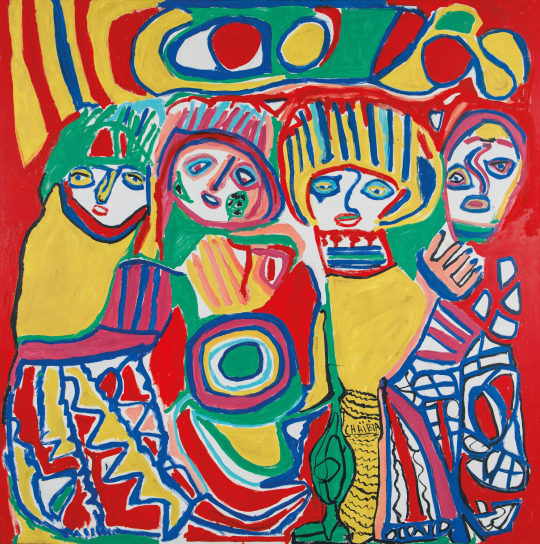
One of them is Chaibia Talal, one of the most influential Moroccan artists of the 20th century. Her story is especially extraordinary and touching. She was born in 1929 in a small village and married at age 13; her husband died when she was 15 years old. As a young widow and mother, she had no choice but to work as a cleaner in order to sustain herself and her son. She was illiterate.
She began painting in 1963 after having a “prophetic” dream that encouraged her to start painting. Her son had a painting studio, and that is where the art curator Pierre Gaudibert discovered her art work for the first time.
Chaibia Talal was a self-taught artist and she was exhibited all around the world. Although her work wasn’t well received in her time, she is now considered as a pioneer figure of Modern Moroccan Art.
The reason why it is important for me to talk about this artist comes from a need to discover more other Moroccan female artists that I can look up to.
Her work is extremely colourful; she was influenced by the “COBRA” avant-garde European art movement, but also pulled a lot of her themes from moroccan culture, depicting moroccan women in traditional costumes. There is an evident play with figuration and abstraction, and the very consistent use of patterns is also an echo to moroccan culture and craft.
Pattern making and symbols are an inherent part of Moroccan culture, even before it was a country. The west part of North Africa was actually constituted of nomadic Berbers.
These nomadic group of people would worship different divinities and symbols would be used both as protection, directly on the skin in the form of tattoos, or on the fabric they made and wore. Clothing was especially important as it was an indication not only of social status, class and wealth but also an indication of the nomadic group they belonged to.
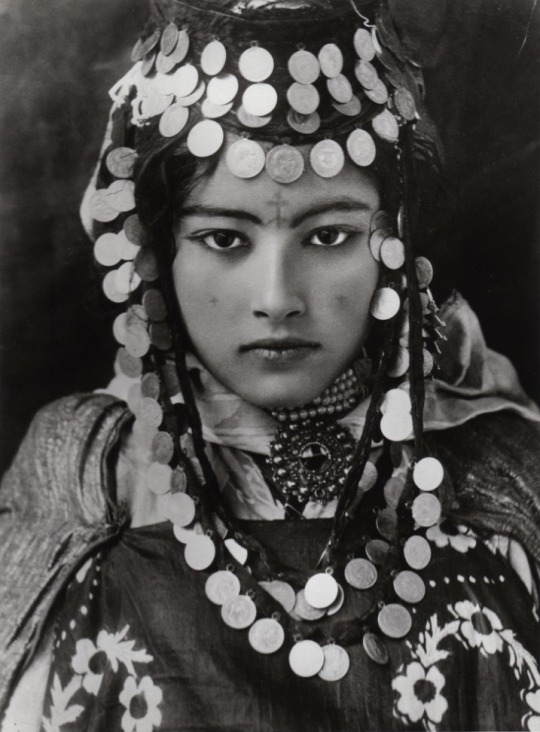
Symbols had associated meaning with different purposes.

Pattern making became even richer after Islamic influences arrived in North Africa. Indeed, it is prohibited in the religion to depict God or any divine figure to Man’s image. Subsequently, symbols and patterns were used to palliate to this. Calligraphy was, and still is, a highly valued form of art; Koranic texts would be embellished and treated as images as opposed to just writing.


Geometry and symmetry was seen as a high form of art as well; there is an element of repetition, interlacing shapes, texts, and symbols that is prevalent throughout Moroccan Art, and craft History.

Symbols have always interested me whether it be part of my heritage, or other new found interests, such as the occult. I have always been fascinated by how different meanings and interpretations can be pulled out of one image or symbol. How visuals can be transformed and used as a new form of language.
There is also a very superficial reason to this as well. There is something about looking at an accumulation of symbols on one images that is, to me, pleasing to the eye. Even if I can’t necessarily fully comprehend the artist’s intention behind every details of their work, I naturally associate a meaning to it based on my own experience and subjectivity.
A good example of this would be Hieronymus Bosch’s “The Garden of Earthly Delights”.

I am aware of its religious ties, and there are extended interpretations made of this triptych oil painting. Yet, I much prefer look at it and create my own narratives out of the images and symbols I can observe from it. I enjoy the fact that there are a multitude of narratives enfolding on one big image.
In tarot as well, each card is illustrated with specific visuals that aid in the interpretation of its messages. The cards, put side by side, form a narrative that is enriched by a diversity of symbols.
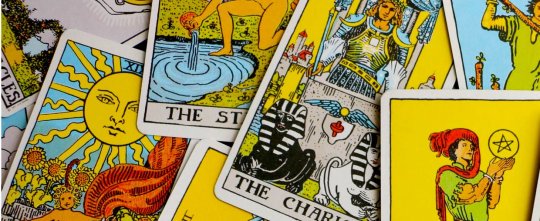
Folklore too, have consistently used symbols and metaphorical analogies to express a deeper meaning.
The French fabulist Jean de la Fontaine is well known for using animals, insects and plants to convey more sensitive messages, at a time where criticising the King and his court was a real offence and a punishable crime.

After listing down all of the things that I loved, I realised that they weren’t so impossible to connect. At a first glance, they seemed impossible to link, but they all share a similarity: they all use symbols and images to attach personal meanings to them or convey certain messages or narratives.
In conclusion, I would like to develop my own “Visual Dictionary/Library”, or at least start this process.
Through this project, my aim refocused on its intended purpose, which was the expression of self through a diverse set of symbols and images.
By doing so, I go back to my very early iterations from Elaborate, where my work was more emotion-based; I intend on keeping the idea of self-reflection through making and researching, in order to develop my own visual language.
10 notes
·
View notes
Photo

AA VFX- 8K & 4K Most Viewed Motion backgrounds channel https://www.facebook.com/AAvfx/ https://www.instagram.com/aa_vfx/ Moving Backgrounds, Backdrops, Animated Live Wallpapers! HD & UHD Videos 2160p, 4320p , VJ Loops, VFX Animations! Consider Donating for more DAILY ONLINE ANIMATIONS: http://www.paypal.com/cgi-bin/webscr?... Dozens of playlists: Tutorials, Effects, Compilations: https://www.youtube.com/dvdangor2011/... Full content online, 8K / 4K & HD Packs , CG background, Green Screen, VFX, Effect footage for your private ,educational, offline/Online use in video projects under the U.S 'Fair Use' usage practice, as long as it doesn't conflict with the provider's policy. It's also advised to keep up with U.S and European legal changes referring to online re-used material for your own safety. Add Credit + Hyperlink attached to you work, For Ex.: Motion Backgrounds by: "#AAvfx" https://www.youtube.com/dvdangor2011 on your file description or website. Terms of Use: -Don't Re-Upload to another source 'as is', in the original form. -Don't activate YouTube's ID Content System with my art. -Don't Re-upload to an external server or 3rd party portal. -Don't exploit, sell my art or harm 'AA VFX' in any way. -Don't use my art inside 3rd-party game platforms -Don't re-post on collective background platforms -Don't present my works as your own original creation -Don't create an outside duplicate animation database source -Don't act against U.S & European laws for re-used copyrighted art. More info on the official website. 8K-video , 8K-animation , 8k-60fps-50fps , Beautiful Backdrops for editing , Special effects for video edits , LED screen & VJ Loops , Best & most amazing live wallpapers , Highest Quality Animation Design , Worship, Sci-fi, Nature , Retro , Electrics, Creatures, Robotics, Graphics , Colorful, Blue, Red, Green, Orange, Clouds, Lightening, Space, Nebula, Star-field, Wormhole, Portal, TNG Star Trek, Doctor Who, 8K & 4K Playlists, Visuals, Video Reel, Digital & Abstract Demo, DJ VJ Show Material, GTX, RTX, PC, Mac, Hardware, Gaming, Game, Cool, Best, Fast, Slow, Meditation, God, Angels, Bible, Secrets, Church, Peace, Peaceful, World, New, UHD, Full-HD, HQ, Lyric Music Video Clip, Adobe After Effects, Blender, Tutorial, Tricks, Tips, HitFilm, Fusion, Flame, Autodesk, BMD, Learn, How to, Modern Music Trippy VJ Artistic Alien Futuristic Visuals, Sacred Geometry, Geometric UFO Future Computer Beauty #AA-vfx #AAvfx #Motion #4KVideo #8KVideo #Free #VJLOOPS #VJ #DJ #8KAnimation #Best #Cool #True #Party #Event #Wedding #Show #Light #Abstract #Art #Amazing #Free #Design #Effects #Tunnel #Spiritual #Meditation #Backgroundפחות פריטים
2 notes
·
View notes
Photo


Communication Design - Week 6
During our week six tutorial class with Ben we looked further at typography and went into discussing letter leading and tracking. It was super interesting to see how errors in tracking and leading can create a completely different words. This lead us into the art movement of Rayonism. This movement caught my attention and lead me into some further reading:
Rayonism is an early form of abstract art characterised by interacting linear forms derived from rays of light. The first image is from Michel Larionove from 1913 and the second is from his partner Natalia Goncharova in 1912. This movement was a new way to express energy and movement through a linear lens. Rayonism is a subset of Russian Futurism and was considered a modern movement that incorporated characteristics of a traditional folk culture. This art movement was derived from Russia’s nationalist culture and this element became a distinctive marker against other European movements such as Cubism, Orphism, German Experssionism and Futurism.
Images from: https://www.tate.org.uk/art/art-terms/r/rayonism
2 notes
·
View notes
Photo
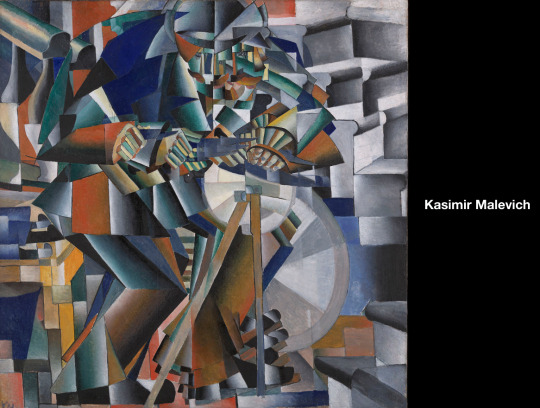


Week 8 Tutorial - continued
We also got to know about Futurism during the class. Ben showed some of the artworks, which one of them is by Kazimir Malevich. Futurism was an Italian art movement which often used modern representational depicts to create a striking subjects on the artwork. But, Malevich is opposite, he used an avant-garde formal vocabulary to represent traditional subjects. His artworks focus on the technical progress of the modern machine age, dynamism, speed, energy, vitality and change. His artworks are abstract as they only use geometric shapes. Then he developed his artwork which is to Suprematism art movement. I saw that each part of shape has used tone which from dark to light colours.
Suprematism focused on geometry and a vocabulary of a few simple shapes like the cross, square, and circle and a limited colour palette. As you can see, two picture at the bottom, they totally used geometric shapes and creates an abstraction on the artwork.
I really like how the artwork can communicate by only using simple shapes and colours. When I saw this as the first time, I feel like it is related with Bauhaus art movement as they also similar characteristic with suprematism. After I did a research, it is actually influenced by Bauhaus. I was impressed with the artwork that are simple but its unique.
Resources:
Wikipedia, 2020, ‘Kazimir Malevich’, viewed 12 May 2020, <https://en.wikipedia.org/wiki/Kazimir_Malevich>.
1 note
·
View note